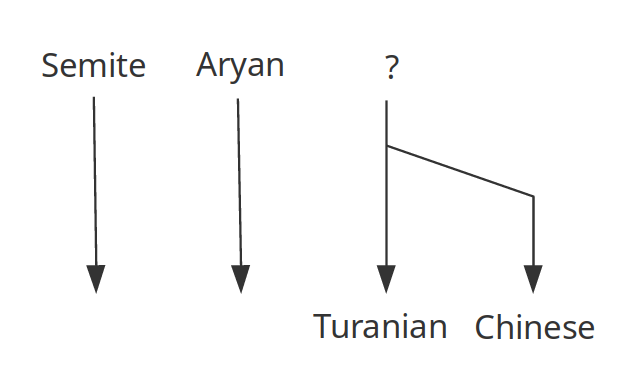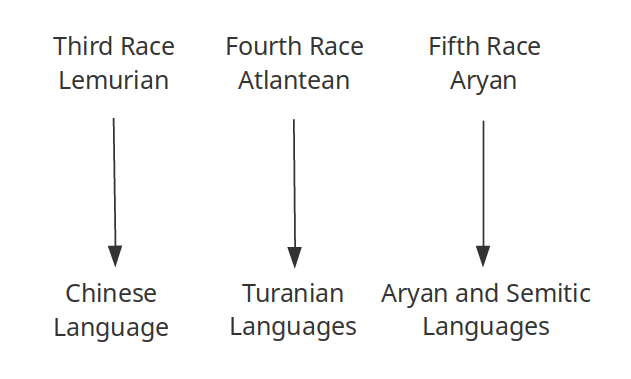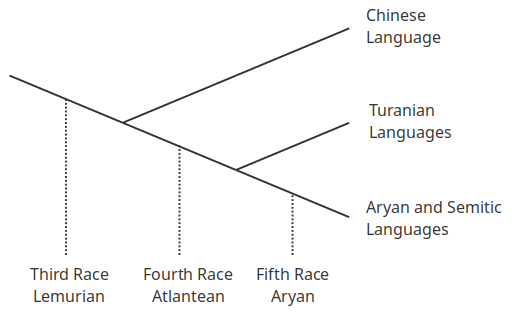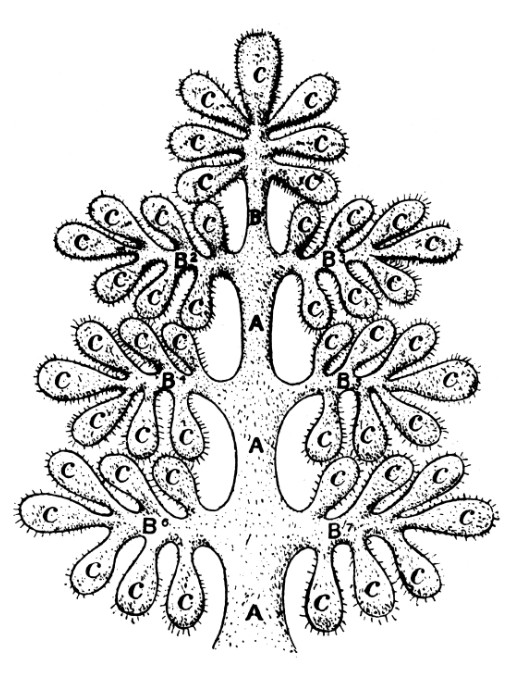Introduction
In volumes I and II of H.P. Blavatsky’s The Secret Doctrine (SD), the word “turanian” is mentioned 14 times. The variants Tur, Turan, the Turanians, Turanian languages and religions are mentioned quite frequently in the SD and several of her other writings. Sometimes the term is used in rather crucial passages. Our question here may be: who did HPB mean when she used the word Turanians?
Max Müller’s Model of Language Development
An illustrative example of the use of the term Turanian is the following, from SD I, xxix:
Nevertheless, having found that “there is a natural connection between language and religion”; and, secondly, that there was a common Aryan religion before the separation of the Aryan race; a common Semitic religion before the separation of the Semitic race; and a common Turanian religion before the separation of the Chinese and the other tribes belonging to the Turanian class; having, in fact, only discovered “three ancient centres of religion” and “three centres of language,” and though as entirely ignorant of those primitive religions and languages, as of their origin, the professor does not hesitate to declare “that a truly historical basis for a scientific treatment of those principal religions of the world has been gained!”
The professor in this citation is Friedrich Max Müller, who in his 1861 work Lectures on the Science of Language, proposed a threefold model of language development, comprising three separate language families: Semite, Aryan and Turanian. Müller’s Semite and Aryan families correspond with our modern Semite and Indo-European language families. Turanian then corresponds largely to the Altai and Uralic languages (Turkish, Hungarian, Finnish, Mongolian, etc.), but also includes for example Tibetan and Burmese (now Sino-Tibetan), Thai (now Dai), Yeniseian (now Dené-Yeniseian), and Tamil and Telugu (now Dravidian). We might say that initially the Turanian family contained grosso modo every language which did not fit into the other two. Most of the currently known African, American and Polynesian languages and language families are not part of the threefold model, as they did not yet receive full attention of language researchers in Müller’s time.
In Müller’s later works on historical linguistics, Chinese is more decisively seen as separate from the Turanian family. Chinese has a more “primitive” grammatical structure than Turanian, and while the Turanian languages would correspond to nomadic people, Chinese would be a language suited for a more “family-oriented” people, as Müller suggested. In the quotation from SD I, xxix, HPB reflects the idea that within a certain period of time the Chinese tribes would have split off from the other Turanian tribes.

HPB’s View on the Turanian Languages
In several places in the SD, we find the Chinese tribes or peoples explicitly mentioned as separate from the Turanian tribes, as in SD I, 113:
This esoterism […] cannot be claimed by the Turanians, so-called, the Egyptians, Chinese, Chaldeans, nor any of the Seven divisions of the Fifth Root Race, but really belongs to the Third and Fourth Root Races, […]
HPB’s subtle criticism on Müller’s ideas may be discerned in the words “Turanians, so-called”. HPB also mentions that “The occult doctrine admits of no such divisions as the Aryan and the Semite, accepting even the Turanian with ample reservations.” In Isis Unveiled I, 576n we already find the same critical tone in her definition of “Turanian”:
The appropriate definition of the name “Turanian” is, any ethnic family that ethnologists know nothing about.
In SD II, 198, Müller’s ideas on language development are explained in somewhat more detail by HPB, correlated to the various early races according to the views presented in the SD.
Monosyllabic languages are related to the third race, “that of the first approximately fully developed human beings at the close of the Third Root-race, the ‘golden-coloured,’ yellow-complexioned men, after their separation into sexes”. Agglutinative languages are related to the Atlantic, fourth race, and inflectional languages to the Aryan and Semitic races. Müller also calls the Chinese language “monosyllabic”, which he sees as a more primitive stage of language development. The designation “agglutinative” covers the Turanian language group.

In the nineteenth century discussion on human evolutionary development, one of the key questions was: did the various human races develop from different isolated origins, or did they develop from one root stock? The first point of view was termed polygenism and the second monogenism. It is only in our time that science has developed a more realistic view of human development, explaining, incorporating and placing relative to each other the arguments for and against poly- and monogenism respectively.
HPB clearly does not agree with Müller’s theory of the three separate origins and, as we may know, in the view presented in the SD, the different races are, very importantly, not separate developments, as the fourth race has its origin in the third, as again the fifth in the fourth. For instance in SD II, 425 she conveys that the Turanians and Chinese have the late third race as a common ancestor:
They “of the yellow hue” are the forefathers of those whom Ethnology now classes as the Turanians, the Mongols, Chinese and other ancient nations; […]
Combining these opposing ideas, of relatively separate evolutionary entities on the one hand and their common ancestor on the other, we may think of the following structure:

From a modern point of view, a structure like this looks more realistic, resembling a modern “genetic tree diagram”. We see that the early races develop from each other, while the different individual cultures or languages all descend from a central line of development. Moreover, according to HPB, race mixing to form new civilisations is also a mechanism actually taking place, which is not taken into account in this diagram.
In SD II, 434 the following diagram is given:

In the description of this diagram, the letter A represents a “root race”. Today we would call these evolutionary strands differently, but for reference we need the original terminology here. Examples of root races are the Third, Fourth and Fifth Race mentioned above, termed Lemurian, Atlantean and Aryan respectively, all with the necessary reservations. Sub-races are indicated with the letter B, even smaller groupings with the letter C. We can see that in this diagram, evolutionary entities are all connected, and develop from each other. They evolve from one strand, but form their individual niches, showing both viewpoints, of polygenism and monogenism, in one diagram.
HPB refers to the work of Jean Armand de Quatrefage (1810-1892), a well-known monogenist of her day, when arguing that humanity has developed from one stock and that new races are formed by race mixing. (SD II, 444) Further she argues that the root races “overlap with several hundreds of millenniums”. (SD II, 445) In her view, evolutionary entities do not only die out by extinction of all individuals, physically disappearing without a trace, but, apparently in other cases, carry over their evolutionary heritage to the next entity during an overlapping period of genetic mixing. This is all of course only a theory from the perspective of the physical development of man, while HPB advocates also a spiritual development in relation to the former. In that respect her view is fundamentally different from that of her contemporary, Charles Darwin.
The Fourth Sub-race of the Fourth Race
In only one location in the SD, namely in I, 319, we find the word Turanian associated with the fourth sub-race of the Fourth Race:
[…] from the commingling of the 4th and 5th sub-races (the Mongolo-Turanian and the Indo-European, so-called, after the sinking of the great Continent) […]
It may be noted that in later theosophical writings, the 4th sub-race is called Turanian and the 6th sub-race is called Mongolian, for instance in William Scott-Elliot (The Story of Atlantis, 1896), Annie Besant (The Pedigree of Man, 1904), Annie Besant and Charles W. Leadbeater (Man, Whence, How and Whither, 1913), and in the works of Rudolf Steiner. Gottfried de Purucker has a different view on the fourth sub-race, apparently keeping closer to the text of the SD, calling it the Mongolian sub-race.
Concluding
HPB accepts the idea that the Turanian peoples as defined by Max Müller are indeed an evolutionary entity, having a common culture and religion, be it with ample reservation. The current Turanian peoples are seen as descendants of the Fourth Race, and are associated with its fourth sub-race. As the Chinese peoples have descended from the Third Race, they do not fall under the heading of Turanians proper. The Chinese language is a monosyllabic (isolating) language and as such it does not fit the profile of a Turanian language. According to the SD, the Turanian languages are the result of an essential development taking place during the Fourth, Atlantean, Race. The Turanian languages are defined as the agglutinative languages, which are primarily the Altai and Uralic language groups. The Turanian peoples are seen as the evolutionary entities communicating by means of these languages. ■
© 2023 Ingmar de Boer, published in The Netherlands
Download as PDF: